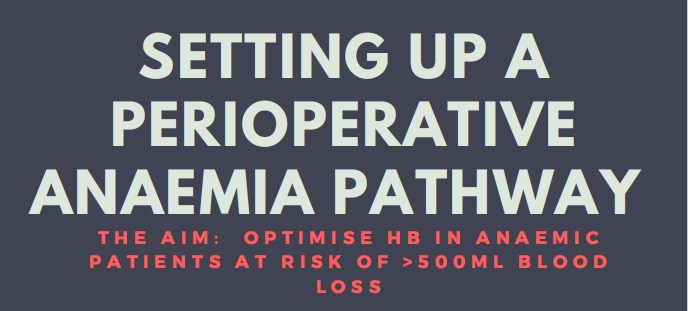Addressing preoperative anaemia: Ten top tips, practical advice and the evidence base
By Anne-Marie Bougeard on behalf of the RCoA Perioperative Medicine Programme
View the accompanying infographic here.
View this guidance in pdf format.


One of the key priorities for PQIP in the coming year is the identification and management of perioperative anaemia. In the Annual Report we have identified current practice and signposted to current guidelines on the management of perioperative anaemia. However, we appreciate that this requires significant changes to practice and is not without controversy. Anaemia is a key focus of the Perioperative Medicine Programme and we recently ran a workshop at the RCoA for Local Leads in Perioperative Medicine and their colleagues to help with setting up an anaemia service. Read on to find out the key themes of the workshop together with further reading and resources.
1. Anaemia is associated with adverse perioperative outcomes and is potentially modifiable
There is a growing body of evidence suggesting that perioperative anaemia is independently associated with adverse outcomes such as increased length of stay, complications and mortality (1). Although level 1 evidence for treatment of anaemia in this context is lacking, it is recommended by international consensus (2) that we should treat anaemia in patients at risk of major blood loss (>500ml) in the perioperative period. It is recommended that institutions should have a pathway to investigate the cause of anaemia in their patients and a clear stepwise approach to intervention based on the clinical picture and the time available before surgery.
2. Why treat preoperatively?
One of the main reasons for treating ‘mild’ anaemia is to avoid or minimise perioperative blood transfusion. The reasons for this are multiple: allogenic blood transfusion carries a risk of transfusion reaction ranging from mild to severe; there are subtle associations with adverse cardiovascular events (3); there is an association between blood transfusion and recurrence rates in cancer (4); there is a cost implication for transfusion, and blood is a finite resource. Although in general we practice a restrictive transfusion policy, in a mildly anaemic patient in whom it may be ‘safe’ to go ahead with surgery, a given volume of blood loss takes them closer to the transfusion and their likelihood of needing blood transfusion greater. There is a significant difference in transfusion rates even between a preoperative Hb <120 and 120-130g/l5. In an audit of cardiac patients from 2010-2016, anaemia was associated with an increased length of stay of 2 days, an increased likelihood of massive transfusion (17.4% vs 6.9%), and an increased in-hospital mortality (5.6% vs 2.3%). Hb concentrations of less than 110g/l were associated with a significant increase in mortality risk.
The prevalence of anaemia is significant in the cohort of patients we are recruiting to PQIP: almost 2000 patients (35%) of PQIP patients undergoing elective (rather than expedited) surgery were anaemic.
Another consideration is the current WHO definitions of anaemia. These state <130g/l for men and <120g/l for women. However, in the perioperative setting this is rather illogical. At surgery women are just as likely to bleed as men, and have a smaller blood volume, therefore will become more anaemic for a given volume of blood loss. Hence the new recommendations are that we target the same value for males and females. Indeed, there is some evidence that women with preoperative anaemia have worse outcomes (3).
The published evidence is also supported by NICE guidance (8,9) and guidance from the British committee for standards in haematology (10), all of which recommend treating preoperative anaemia.
So, how do we do it? Our experts gave the following advice, which is also summarised in the attached infographic:
3. Define your local problem
To build a case for introducing a new service you will be expected to define the problem in your own institution. Audit your incidence of preoperative anaemia, your rates of intervention for preoperative anaemia, your rates of transfusion and length of stay, readmission rates and unplanned critical care admissions. If possible collect data on other components of a good patient blood management programme, e.g. use of tranexamic acid where appropriate, use of cell salvage, management of anticoagulation.
4. Talk to primary care
It is impossible to institute an anaemia pathway without liaison with primary care. It is hugely important to explain the rationale for treating mild anaemia, as many of the patients we will be asking the general practitioners to treat would not normally be treated. Ideally, ask for referral with a recent haemoglobin to identify patients who need intervention as early as possible.
5. Identify your stakeholders
This involves a multidisciplinary approach. Haematologists are key here, and should help you in developing a pathway which will suit your local needs. The laboratory can be really helpful in finding ways of running haemiatinics in patients identified as anaemic on pre-operative bloods without calling patients for further tests. Find out how your perioperative service is funded and how you can engage with your local commissioners to fund a new service. Identify where in your hospital intravenous iron is already being administered, what is on your formulary and what the approved indications are, as you may find it far easier than expected to use existing services. Bear in mind that gastroenterology and nephrology use intravenous iron frequently and will have a wealth of experience to help you. Your transfusion nurse specialist may be an invaluable resource, and you will need to educate your preassessment team on the rationale for the pathway and how to identify and investigate patients.
6. Develop a pathway which works for your hospital
This will need to account for what surgery is being performed and what the average interval is between listing for surgery and admission. The consensus guidelines provide a very useful pathway for approaching perioperative anaemia taking into account diagnosis, treatment in the case of a long interval to surgery, treatment of patients who do not respond to oral iron and those who do not tolerate oral iron, and those in whom there is less than six weeks prior to surgery. Liaise with colleagues in your region, as it is likely someone will have developed a pathway which can be adapted. An example of this is the North West Pre-operative Anaemia Project.
7. Writing a business case
This can seem daunting, however can be achieved by collecting your data as described above, by looking at tariffs and HRG codes for commissioned services, identifying the costs of additional nursing and clerical time, blood tests and the costs of drug treatment. This should be balanced against the cost of transfusion and the cost of excess length of stay. It is worth pointing out that there are tangible clinical benefits which do not translate into length of stay or transfusion costs. Enlist the help of your pharmacists and the pharmaceutical companies, some of which have model business cases into which you can enter your data. Ensure you are clear what type of service you are running, namely, a perioperative anaemia pathway rather than an anaemia clinic which will likely exist elsewhere in the hospital.
8. Overcoming barriers
- Think about how to provide support to GPs to diagnose and manage iron deficiency in community by working with your medical specialty colleagues.
- Learn from others in and outside your organisation on how is best to go ahead: business planning versus stealth implementation.
- Work across boundaries - work out how to align with your local STP or ICS plans. It is a challenge to prove the investment is worthwhile so consider emphasising the effects on the system as a whole: tariffs, readmission rates, reduced use of GP services downstream, holistic patient care.
9. Decide on your criteria for postponement
Clearly this will vary on a case by case basis and will be dictated by clinical priorities. Nevertheless, it is a discussion which must be had with the surgical and anaesthetic teams and involve the patient in a shared decision on the merits of proceeding with surgery when anaemic.
Clearly there are situations in which clinical urgency trumps intervention on anaemia, however it is a reasonable aspiration that trusts should have a mechanism for identifying anaemia and treating it where possible in those patients at high risk of blood loss >500ml. In patients who have surgery, careful consideration should be given to other components of a patient blood management programme to mitigate the effects of blood loss.
We are planning to put resources on the Perioperative Medicine page of the RCoA website, however the key references to support a business case are listed below. If you need support or to be put in touch with a colleague who has introduced an anaemia pathway please get in touch: perioperativemedicine@rcoa.ac.uk
10. Further reading to help support writing a business case and implementation
National Comparative Audit of Blood Transfusion 2015 [online] http://hospital.blood.co.uk/audits/national-comparative-audit/
The North West Pre-op Anaemia Project [online] http://hospital.blood.co.uk/patient-services/patient-blood-management/pre-operative-anaemia/
Shander A, Ferraris VA. More or less? The Goldilocks Principle as it applies to red cell transfusions. BJA 2017;118(6):816-9
Johansson PL, Rasmussen AS, Tomsen LL. Intravenous iron isomaltoside 1000 (Monofer) reduces postoperative anaemia in preoperatively non-anaemic patients undergoing elective or subacute coronary artery bypass graft, valve replacement or a combination thereof: a randomized double-blind placebo-controlled clinical trial (the PROTECT tiral). Vox Sanguis 2015;109:257-66
Froessler B, Palm P, Weber I, Hodyl NA, Singh R, Murphy EM. The important role for intravenous iron in perioperative patient blood management in major abdominal surgery. Ann Surg 2016; 264: 41-46.
Litton E, Ho KM. Safety and efficacy of intravenous iron therapy in reducing requirement for allogenic blood transfusion: systematic review and meta-analysis of randomized clinical trials. BMJ 2013;347:f4822
References
1. Musallam KM, Tamim HM, Richards T, Spahn DR, Rosendaal FR, Habbal A et al. Preoperative anaemia and postoperative outcomes in non-cardiac surgery: a retrospective cohort study. Lancet 2011;378: 1396-407
2. Munoz M, Acheson AG, Auerbach M, Besser M, Habler O, Kehlet H et al. International consensus statement on the peri-operative management of anaemia and iron deficiency. Anaesthesia 2017;72:233-47
3. Whitlock EL, Kim H, Auerbach AD. Harms associated with single unit perioperative transfusion: retrospective population based analysis. BMJ 2015;350: 3037
4. Amato A, Pescatori M. Perioperative blood transfusions for the recurrence of colorectal cancer. Cochrane Database Syst Rev 2006 vol Jan CD005033
5. Blaudszun G, Munting KE, Butchart A, Gerrard C, Klein AA. The association between borderline pre-operative anaemia in women and outcomes after cardiac surgery: a cohort study. Anaesthesia 2018;73(5):572-8
6. Klein AA, Collier TJ, Brar MS, Evans C, Hallward G, Fletcher SN et al. The incidence and importance of anaemia in patients undergoing cardiac surgery in the UK – the first Association of Cardiothoracic Anaesthetists national audit. Anaesthesia 2016; 71:627-35
7. Munoz M, Laso-Morales MJ, Gomez-Ramirez S, Cadellas M, Nunez-Matas MJ, Garcia-Erce JA. Pre-operative haemoglobin levels and iron status in a large multicenter cohort of patients undergoing major elective surgery. Anaesthesia 2017; 72(7): 826-834
8. NICE guideline 24 on blood Transfusion 2015 [online] www.nice.org.uk/guidance/ng24
9. NICE quality standard 138 on blood transfusion 2016 [online] www.nice.org.uk/guidance/qs138
10. Kotze A, Harris A, Baker C, Iqbal T, Lavies N, Richards T et al. British Committee for Standards in Haematology guidelines for the identification and management of pre-operative anaemia. Br J Haem 2015:171;322-31


